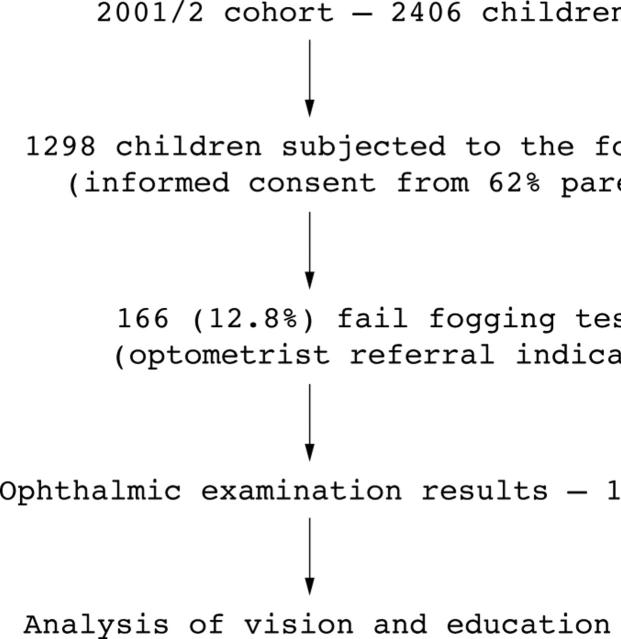Abstract
Background: Vision screening addresses the visual impairments that impact on child development. Tests of long-sightedness are not found in most school screening programmes. The evidence linking mild-moderate hyperopia and lack of progress in school is insufficient, although strengthened by recent findings of developmental problems in infants.
Aims: To report on the relation between hyperopia and education test results in a cohort of primary school children.
Methods: A total of 1298 children, aged 8 years, were screened for hyperopia on the basis of fogging test results. School test results (NFER and SATs) were compared between groups categorised by referral status and refractive error.
Results: A total of 166 (12.8%) fogging test failures were referred for ophthalmic assessment. Ophthalmic tests on 105 children provided an accurate diagnosis of vision defects, for reference to their education scores. Fifty per cent of the children examined by optometrists required an intervention (prescription change, glasses prescribed, or referral). Mean (95% CI) NFER scores of children with refractive errors (summed for both eyes) >+3D (98.4, 93.0–103.8, n = 32) or >+1.25D (best eye) (99.3, 93.0–105.6, n = 26) were lower than the respective scores of children with a less positive refractive state (104.8, 100.7–108.9, n = 43) (103.6, 99.7–107.4, n = 49), the non-referred group, and total sample. The SATs results followed a similar trend. A high proportion of the fogging test failures (16%) and confirmed hyperopes (29%) had been referred to an educational psychologist, and the latter group contributed substantially to the poor education scores.
Conclusions: The results of this study provide further evidence for a link between hyperopia and impaired literacy standards in children.
Full Text
The Full Text of this article is available as a PDF (70.0 KB).
Figure 1.
Vision screening and educational assessment components of the study.
Selected References
These references are in PubMed. This may not be the complete list of references from this article.
- Atkinson Janette, Anker Shirley, Nardini Marko, Braddick Oliver, Hughes Claire, Rae Sarah, Wattam-Bell John, Atkinson Sue. Infant vision screening predicts failures on motor and cognitive tests up to school age. Strabismus. 2002 Sep;10(3):187–198. doi: 10.1076/stra.10.3.187.8125. [DOI] [PubMed] [Google Scholar]
- Bamford J., Davis A., Boyle J., Law J., Chapman S., Brown S. S., Sheldon T. A. Preschool hearing, speech, language, and vision screening. Qual Health Care. 1998 Dec;7(4):240–247. doi: 10.1136/qshc.7.4.240. [DOI] [PMC free article] [PubMed] [Google Scholar]
- Ciner E. B., Dobson V., Schmidt P. P., Allen D., Cyert L., Maguire M., Moore B., Orel-Bixler D., Schultz J. A survey of vision screening policy of preschool children in the United States. Surv Ophthalmol. 1999 Mar-Apr;43(5):445–457. doi: 10.1016/s0039-6257(99)00021-1. [DOI] [PubMed] [Google Scholar]
- Cummings G. E. Vision screening in junior schools. Public Health. 1996 Nov;110(6):369–372. doi: 10.1016/s0033-3506(96)80010-2. [DOI] [PubMed] [Google Scholar]
- Grisham J. D., Simons H. D. Refractive error and the reading process: a literature analysis. J Am Optom Assoc. 1986 Jan;57(1):44–55. [PubMed] [Google Scholar]
- Hartmann E. E., Dobson V., Hainline L., Marsh-Tootle W., Quinn G. E., Ruttum M. S., Schmidt P. P., Simons K., Maternal and Child Health Bureau and national Eye Institute Task Force on Vision Screening inthe Preschool Child Preschool vision screening: summary of a task force report. Ophthalmology. 2001 Mar;108(3):479–486. doi: 10.1016/s0161-6420(00)00588-1. [DOI] [PubMed] [Google Scholar]
- Hård Anna-Lena, Sjödell Lena, Borres Magnus P., Zetterberg Ingrid, Sjöstrand Johan. Preschool vision screening in a Swedish city region: results after alteration of criteria for referral to eye clinics. Acta Ophthalmol Scand. 2002 Dec;80(6):608–611. doi: 10.1034/j.1600-0420.2002.800609.x. [DOI] [PubMed] [Google Scholar]
- Jayatunga R., Sonksen P. M., Bhide A., Wade A. Measures of acuity in primary-school children and their ability to detect minor errors of vision. Dev Med Child Neurol. 1995 Jun;37(6):515–527. doi: 10.1111/j.1469-8749.1995.tb12039.x. [DOI] [PubMed] [Google Scholar]
- Kvarnström G., Jakobsson P., Lennerstrand G. Visual screening of Swedish children: an ophthalmological evaluation. Acta Ophthalmol Scand. 2001 Jun;79(3):240–244. doi: 10.1034/j.1600-0420.2001.790306.x. [DOI] [PubMed] [Google Scholar]
- Köhler L., Stigmar G. Testing for hypermetropia in the school vision screening programme. Acta Ophthalmol (Copenh) 1981 Jun;59(3):369–377. doi: 10.1111/j.1755-3768.1981.tb03002.x. [DOI] [PubMed] [Google Scholar]
- Rosner J., Rosner J. The relationship between moderate hyperopia and academic achievement: how much plus is enough? J Am Optom Assoc. 1997 Oct;68(10):648–650. [PubMed] [Google Scholar]
- Steele Gregg, Ireland Dennis, Block Sandra. Cycloplegic autorefraction results in pre-school children using the Nikon Retinomax Plus and the Welch Allyn SureSight. Optom Vis Sci. 2003 Aug;80(8):573–577. doi: 10.1097/00006324-200308000-00010. [DOI] [PubMed] [Google Scholar]
- Stewart-Brown S. L., Haslum M. Screening of vision in school: could we do better by doing less? BMJ. 1988 Oct 29;297(6656):1111–1113. doi: 10.1136/bmj.297.6656.1111. [DOI] [PMC free article] [PubMed] [Google Scholar]
- Stewart-Brown S. L., Snowdon S. K. Evidence-based dilemmas in pre-school vision screening. Arch Dis Child. 1998 May;78(5):406–407. doi: 10.1136/adc.78.5.406. [DOI] [PMC free article] [PubMed] [Google Scholar]
- Stewart-Brown S., Haslum M. N., Butler N. Educational attainment of 10-year-old children with treated and untreated visual defects. Dev Med Child Neurol. 1985 Aug;27(4):504–513. doi: 10.1111/j.1469-8749.1985.tb04575.x. [DOI] [PubMed] [Google Scholar]
- Strawhacker MaryAnn Tapper, Gustafson Jeri K., Kinne Marilyn J., Little Donita. Vision screening practices in central Iowa: a follow-up evaluation. J Sch Nurs. 2003 Apr;19(2):111–118. doi: 10.1177/10598405030190020801. [DOI] [PubMed] [Google Scholar]
- Thomson W. D., Evans B. A new approach to vision screening in schools. Ophthalmic Physiol Opt. 1999 May;19(3):196–209. doi: 10.1046/j.1475-1313.1999.00421.x. [DOI] [PubMed] [Google Scholar]
- Tong P. Y., Macke J. P., Bassin R. E., Everett M., Enke-Miyazaki E., Tielsch J. M., Stager D. R., Sr, Parks M. M., Beauchamp G. R. Screening for amblyopia in preverbal children with photoscreening photographs. III. improved grading criteria for hyperopia. Ophthalmology. 2000 Sep;107(9):1630–1636. doi: 10.1016/s0161-6420(00)00336-5. [DOI] [PubMed] [Google Scholar]
- Wharry R. E., Kirkpatrick S. W. Vision and academic performance of learning disabled children. Percept Mot Skills. 1986 Feb;62(1):323–336. doi: 10.2466/pms.1986.62.1.323. [DOI] [PubMed] [Google Scholar]



